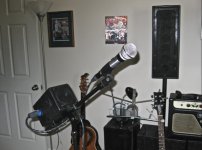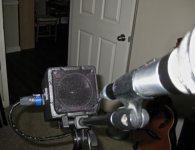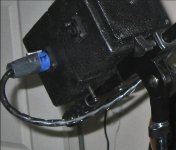Hi everyone,
Looking for diy stage monitors for an acoustic live band, I found this page on the Beyma site: Recommended Enclouse Designs - Beyma.
Here are some very well detailed diy projects. Ideal for someone with a lot of interest, but little experience in loudspeaker construction like me.
The intention is to have small stage monitors for small-scale concerts. For larger gigs, professional equipment is rented.
Because it concerns acoustic music, I thought of 5x 10inch and one 12 inch (for the bass player). I would opt for the slightly more expensive WR series.
I notice that damping material is not mentioned in the PDF. I suppose this is necessary.
Any experience with these speakers or with Beyma ?
General advice is certainly also welcome ;-)
Thanks !!!
I look forward to starting this project!
Johan
Looking for diy stage monitors for an acoustic live band, I found this page on the Beyma site: Recommended Enclouse Designs - Beyma.
Here are some very well detailed diy projects. Ideal for someone with a lot of interest, but little experience in loudspeaker construction like me.
The intention is to have small stage monitors for small-scale concerts. For larger gigs, professional equipment is rented.
Because it concerns acoustic music, I thought of 5x 10inch and one 12 inch (for the bass player). I would opt for the slightly more expensive WR series.
I notice that damping material is not mentioned in the PDF. I suppose this is necessary.
Any experience with these speakers or with Beyma ?
General advice is certainly also welcome ;-)
Thanks !!!
I look forward to starting this project!
Johan
Beyma speakers are VERY high quality ones, no doubts about them.
But plans show somewhat complex cabinets, talking the carpentry side here, needing a precise saw with precision adjustable cutting angles , panel sizes must also be exact within the mm or tighter, not sure an inexperienced builder can be successful, unless you have good modern machinery and lots of experience.
If not building cabinets, maybe making furniture in general.
Do you?
But plans show somewhat complex cabinets, talking the carpentry side here, needing a precise saw with precision adjustable cutting angles , panel sizes must also be exact within the mm or tighter, not sure an inexperienced builder can be successful, unless you have good modern machinery and lots of experience.
If not building cabinets, maybe making furniture in general.
Do you?
Thanks for your reply!
I am indeed not an experienced woodworker, but I'll get help from a professional who will be sawing the pieces. Otherwise it would become a mess ! 😉
I am indeed not an experienced woodworker, but I'll get help from a professional who will be sawing the pieces. Otherwise it would become a mess ! 😉
Those Beyma designs look to be generic multipurpose speakers which are fine if that is how they will be used but you might consider something more specialized like a coaxial floor wedge, B&C has some designs and driver combos in that format like these MC122AN
The drivers.. B&C Speakers
The drivers.. B&C Speakers
Thanks for your reply!
I am indeed not an experienced woodworker, but I'll get help from a professional who will be sawing the pieces. Otherwise it would become a mess ! 😉
Accuracy is the main skill with carpentry.
I cheat a bit by getting my local DIY shop to cut the plywood in strips exactly same width with their huge fancy vertical wood saw.
I then cut them to required lengths carefully.
Because they are same width there are no gaps when gluing.

Further on the coaxial floor monitor idea... I just found these RCF drivers with the matching passive crossover on ebay....
New !Original Vintage RCF L12 CX200 Two Way Loudspeaker W/ Crossover 8 Ohms. | eBay
New !Original Vintage RCF L12 CX200 Two Way Loudspeaker W/ Crossover 8 Ohms. | eBay
Again, thanks for the answers.
Indeed, it is not a bad idea to look at coaxial designs. 10 inch coaxial is not very common in stage monitors, but 12 inch coaxial obviously is.
By searching I came across the "Smithers wedge", which apparently has been built by many people.
The original speaker is way too expensive for what I want to do with it, but the B&C 12FCX76 is suggested as an alternative. This one is comparable in price to the Beyma parts from my original idea.
Maybe I'd make some adjustments to the exterior, e.g. I don't think the handles are that practical and I'd put the foam in front of the grill.
But in general i like this design very much.
Drawback: I think this design will be much heavier, partly because of the 18mm plywood.
Indeed, it is not a bad idea to look at coaxial designs. 10 inch coaxial is not very common in stage monitors, but 12 inch coaxial obviously is.
By searching I came across the "Smithers wedge", which apparently has been built by many people.
The original speaker is way too expensive for what I want to do with it, but the B&C 12FCX76 is suggested as an alternative. This one is comparable in price to the Beyma parts from my original idea.
Maybe I'd make some adjustments to the exterior, e.g. I don't think the handles are that practical and I'd put the foam in front of the grill.
But in general i like this design very much.
Drawback: I think this design will be much heavier, partly because of the 18mm plywood.
Hey, I loved your DIY folded horns 🙂Accuracy is the main skill with carpentry.
I cheat a bit by getting my local DIY shop to cut the plywood in strips exactly same width with their huge fancy vertical wood saw.
I then cut them to required lengths carefully.
Because they are same width there are no gaps when gluing.
And fully agree with the accuracy bit.
Like the old Carpenter said: "measure twice, cut once" 😉
Shouldn't be that bad really, there's going to be roughly the same amount of wood in any cabinet design. You don't have to use 18mm Birch ply either use 15mm, even 12.5mm with some strategic bracing can be strong and rigid. The upside the the floor wedge design is it's more stable.. doesn't want to roll if you casually try to reposition it with your foot while performing for example.Drawback: I think this design will be much heavier, partly because of the 18mm plywood.
Also don't make the box any bigger than it needs to be, put the driver specs into WinISD to see what it needs and scale the box design down if you can.
Johan,By searching I came across the "Smithers wedge", which apparently has been built by many people.
Drawback: I think this design will be much heavier, partly because of the 18mm plywood.
In reading your thread , realized I had never really tested some “mini-monitors” (MM) I had put together several months ago- no gigs since before Covid19...
Set them up and gave them some live listening tests today. For use with a live acoustic band, they offer advantages over a wedge monitor, even those using high quality co-ax drivers as have been suggested, assuming you don’t want much more than 106dB SPL at your ear.
Like Galaxy Audio’s “Hot-Spot” monitors, they use small full range drivers located near the mic, but using even smaller drivers allows less of a visual distraction, and makes it possible to use one boom mic stand for both the MM and microphone, which also puts the monitor near the maximum rejection point of most cardioid microphones.
The MM I built use 3.5” drivers, a pair with B&C 35NDF26, and a pair with Tymphany TC9FD-18-08. They sound good “full range”, 100-Hz to 16kHz, producing in excess of 100dB at the ear, mounted on the mic stand boom.
The Beyma 3FR30 would be similar, though would roll off about an octave higher.
The close proximity of the MM to the performers ear takes advantage of the inverse distance law, sound drops at 6dB per doubling of distance.
To keep up with the MM, mounted on a mic boom producing 100dB at the ear at 1/2 meter- a floor wedge at 2 meters distance typical for standing performers would have to produce 112 dB to achieve the same level.
With acoustic instruments used with floor wedges the instrument mic or pickup is “hearing” a level about 6dB louder than the performer’s ear- the MM typically has about a 6dB gain before feedback advantage over a floor wedge.
Using in-ear monitors provides the best potential for reducing stage volume and maximizing gain before feedback, but using MMs can reduce stage level by 12dB (10dB level reduction sounds about “half as loud”) while still allowing performers to hear at the same level, which makes a huge difference in the overall mix clarity both on stage and in the house.
Although the MM are not going to produce much level below 100 Hz compared to something like the “Smithers wedge” or similar, in most cases the low frequency “spill” of the mains provides plenty (often too much) of low end on stage for a live acoustic band, especially if microphones rather than piezo or magnetic pickups are used.
If the acoustical factors are not convincing you, consider for the cost, size, and weight of one decent co-ax wedge, you could make six of the MMs.
The rectangular box and stand clamp (two T-nuts, two screws and a piece of metal) is easy to make, probably also reducing build time by a factor of six, especially considering the time wiring crossovers.
Cheers,
Art
Attachments
Last edited:
Thanks for the answers...
The idea of mini monitors is certainly interesting, maybe in combination with side fills for medium sized stages.
I once discussed this with someone, but it slipped my mind.
3 inches seems small to me, all the commercial products I came across are 5 inches (Galaxy, Mackie, ...) Here, of course, there is a wooden enclosure, maybe that also contributes.
I do believe it is possible to build something that sounds better than the commercial products.
In the meantime, I'm trying to master WinISD.
The idea of mini monitors is certainly interesting, maybe in combination with side fills for medium sized stages.
I once discussed this with someone, but it slipped my mind.
3 inches seems small to me, all the commercial products I came across are 5 inches (Galaxy, Mackie, ...) Here, of course, there is a wooden enclosure, maybe that also contributes.
I do believe it is possible to build something that sounds better than the commercial products.
In the meantime, I'm trying to master WinISD.
The idea of mini monitors is certainly interesting, maybe in combination with side fills for medium sized stages.
3 inches seems small to me, all the commercial products I came across are 5 inches (Galaxy, Mackie, ...)
A 3.5” driver does seem small, but that size makes for the possibility of mounting it close enough to still provide adequate SPL without being "too big" when mounted on the mic stand.
Most consumers of commercial products would not consider a monitor that would "only" produce around 94-100dB at one meter (even though the MM would be used at half that distance), so manufacturers have little incentive to build them, especially considering the retail price would have to be very low to compete with existing products.
That said, even 100dBA at the ear is enough to cause hearing damage. If you are performing, keep the NIOSH or OSHA Occupational Noise Exposure guidelines in mind, or (like me), you will likely end up with NIHL (noise induced hearing loss) as you age.
NIOSH (1998)
dBA Slow
85 for 8 hours
90 for 2.5 hours
95 for 47 minutes
100 for 15 minutes
OSHA (1998)
dBA Slow
90 for 8 hours
92 for 6 hours
95 for 4 hours
97 for 3 hours
100 for 2 hours
102 for 1.5 hours
105 for 1 hour
110 for 1/2 hour
115 for 1/4 hour
Have fun, be safe!
Art
Last edited:
- Home
- Live Sound
- PA Systems
- Beyma diy speakers


